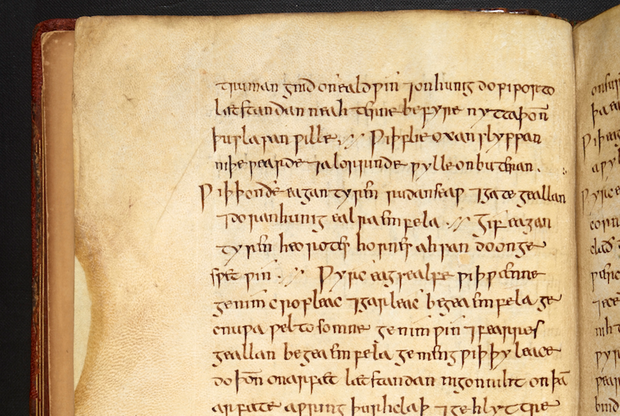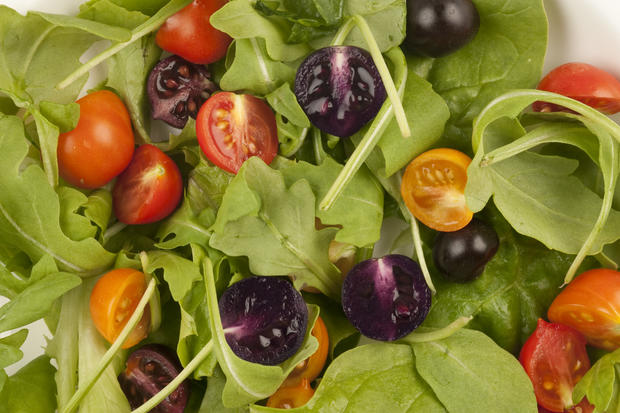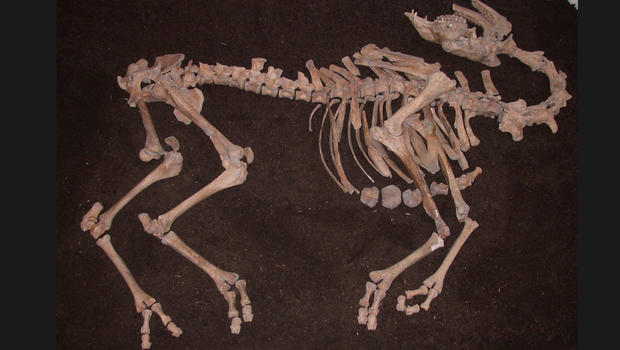Weirdest science news of the week
A recipe for a remedy for eye infections from a 10th Century medical volume called Bald's Leechbook, one of the earliest known medical textbooks, has been found to fight Staphylococcus aureaus, the antibiotic-resistant bacteria MRSA.
In its original Old English, the recipe -- which may date back even further, to the 9th Century -- called for two species of Allium (garlic and onion or leek), wine and bile from a cow's stomach. The topical potion was brewed in a brass vessel, strained and left to sit for nine days.
Researchers used fresh ingredients and made the potion according to the instructions, then exposed populations of bacteria to it. It obliterated the MRSA, killing 999 out of 1,000 bacterial cells.
Read the full story here.
Next...
Pink pineapples and purple tomatoes
Cancer-fighting pink pineapples, heart-healthy purple tomatoes and less fatty vegetable oils may someday be on grocery shelves next to apples that don't brown and potatoes that don't bruise.
Del Monte has engineered a pink pineapple that includes lycopene, an antioxidant compound that gives tomatoes their red color and may have a role in preventing cancer. USDA has approved importation of the pineapple, which would be grown only outside of the United States; it is pending FDA approval. A small British company is planning to apply for U.S. permission to produce and sell purple tomatoes that have high levels of anthocyanins, compounds found in blueberries that some studies show lower the risk of cardiovascular disease and cancer. FDA would have to approve any health claims used to sell the products.
Read the full story here.
Next...
Tarantulas run faster in warm weather
Spiders have developed a unique way to move around: Rather than relying mainly on muscles to move, they use a fluid called hemolymph, which is their blood. When hemolymph flows into their tubelike legs, the limbs extend and their flexor muscles bend the legs at the joint, causing that fluid to flow back out.
Temperature can change the thickness, or viscosity, of hemolymph, said the senior author of a new study, Anna Ahn, an associate professor of biology at Harvey Mudd College in California.
She and her team researchers studied eight adult Texas brown tarantulas (Aphonopelma hentzi). They tested the spiders' speed and agility at four different temperatures: 59, 75, 88 and 104 degrees Fahrenheit (15, 24, 31 and 40 degrees Celsius).
At lower temperatures, the spiders moved more slowly -- likely because the hemolymph was more viscous than at higher temperatures. When the temperature went up, so did the creepy crawlers' speed. On average, the spiders moved about four body lengths a second at 62 F (17 C), and about 10 body lengths a second at 100 F (38 C), a 2.5-fold increase.
Read the full story here.
Next...
Ghosts of quasars past
There are bands of quasar ghosts haunting deep space.
The Hubble Space Telescope has snapped rare images of strange, looped structures that are believed to be long tails of gas formed during a violent merger between two galaxies. These objects were lit up by a blast of radiation from a quasar -- the luminous and compact region that surrounds a supermassive black hole at the center of a galaxy.
It would have taken light from the quasar tens of thousands of years to reach them and light them up. So, although the quasars themselves have turned off, the green clouds will continue to glow for much longer before they too fade.
Read the full story here.
Next...
Ottoman camel skeleton found under Austrian mall
When construction began on a new shopping center in Tulln, Austria in 2006, crews unearthed a number of archaeological finds dating back to the 17th century. Those included a coin from the time of Louis XIV, a bottle of a medieval remedy called Theriacum, and -- rather surprisingly -- a complete camel skeleton.
Uncovered outside Vienna, near the Danube river, the find was traced back to an Ottoman siege in the late 1600s. The nomadic Ottoman army used camels along with horses for transportation, and camel bones have been found here and there across Europe, but a complete skeleton is unique for the region.
"The animal was certainly exotic for the people of Tulln. They probably didn't know what to feed it or whether one could eat it," said archaeozoologist Alfred Galik. "Perhaps it died a natural death and was then buried without being used."
Read the full story here.
Next...
Tiny bird takes a looooong trip
The diminutive blackpoll warbler weighs just 12 grams, or the weight of a dozen business cards, but each year it makes its way from New England and eastern Canada to South America via an amazing journey over the Atlantic Ocean.
A study in the current issue of Biology Letters has determined the birds are making a long-range transoceanic voyage -- a distance of between 1,410 and 1,721 miles -- without stopping to rest. The birds reach landfall most likely on the northeastern coast of South America in just two or three days. From there, they head further inland to northern Venezuela and Colombia.
Read the full story here.
Next...
A volcano that turned summer into winter
Two hundred years ago, half of the world went dark.
The Tambora volcano in what is now Indonesia blew its top in April 1815, killing more than 60,000 people and turning the summer into winter across much of the Northern Hemisphere. It is considered the largest eruption to have occurred in 750 years.
"Because Tambora ejected sulfurous gas that generated sulfate aerosols in the atmosphere, which block sunlight, the eruption created a year without a summer, leading to food shortages -- people were eating cats and rats -- and very general hardship throughout Europe and eastern North America," said Stephen Self, an adjunct professor of earth and planetary science at the University of California, Berkeley and an expert on volcanoes.
Read the full story here.
Next...
Zero-gravity cocktail glass
While so many space companies are focused on building rockets and spacecraft, could there room for a little style in orbit?
This is where Samuel Coniglio said he hopes to fill the gap. The long-time space tourism advocate has created a "zero-gravity" cocktail glass designed to use grooves to keep the liquid in. This would avoid the perennial problem of fluids floating away in orbit, which force astronauts to use straws.
Read the full story here.
Next...
Science proves existence of dragons
A new study published online Wednesday in Nature reviews evidence that dragons may not be figments of the imagination after all.
"Long considered to be the stuff of legend, dragons cross cultures and continents," the authors wrote. "From depictions in Ancient Greek literature and Slavic myth, to the dragons of the East or allusions in Zoroastrian scripture, the descriptions resonate. What if these legends were rooted in truth? The differences in appearance -- some lack wings, some have multiple heads and some seem not to breathe fire -- once thought to reflect local traditions, can also readily be explained by speciation."
Was this a ground-breaking discovery...or just one of many clever April Fool's Day pranks? You be the judge.








